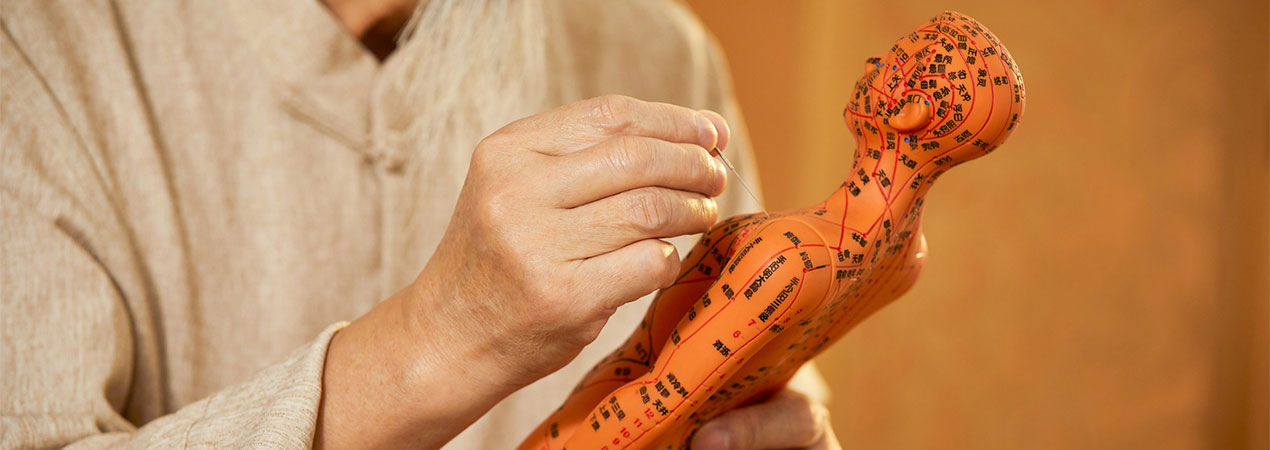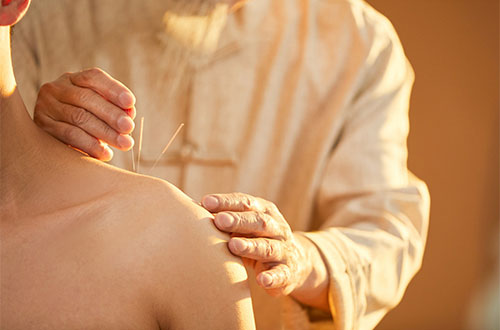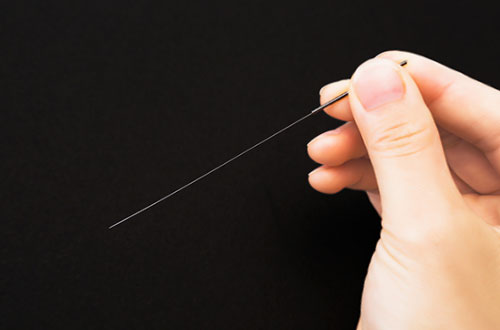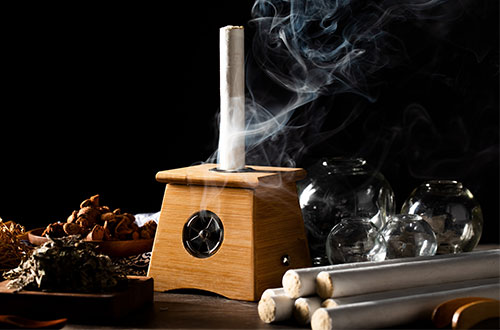Acupuncture and Moxibustion

Acupuncture consists of the insertion of one or several small metal needles into the skin and underlying tissues at precise points on the body. It is an integral part of Traditional Chinese Medicine (TCM). It is now rapidly gaining popularity and is being practiced all over the world.
Acupuncture made headlines in the United States during the early 1970s when an American journalist described acupuncture in a New York newspaper article. Traveling with President Nixon during his historic visit to China, James Reston required an emergency appendectomy. He received acupuncture for post-operative treatment and wrote about it on his return home.
TCM defines acupuncture as a technique that balances the flow of universal life energy, known as ‘chi or qi’. By inserting needles into specific energy pathways or meridians, practitioners believe they can re-balance energy to improve well-being. Western practitioners view acupuncture in a different light. They use the technique to stimulate nerves and muscles. They believe this stimulation improves blood flow and activates natural painkillers in the body.
Origin and History of Acupuncture and Moxibustion
The origin of acupuncture and moxibustion in Chinese history is unclear. One explanation credits arrow punctures with healing soldier wounds. Another says the practice dates back to the Stone Age with the use of sharpened stones as the tool. In China, there is a practice known as Bian Stone using the same technique.

Ancient writing systems suggest that acupuncture and moxibustion were practiced during the Shang Dynasty, (also known as Yin between 1600 BCE and 1000 BCE. It was not until the second century BCE, during the Han Dynasty that metal acupuncture needles replaced those made from stone and bone.
Acupuncture and moxibustion were first recorded in the ancient Chinese medical text from Huang Di Nei Jing (The Yellow Emperor’s Classic of Internal Medicine).The concepts of channels (meridians or conduits in which the Qi (vital energy or life force) flowed are well established by this time, though the precise anatomical locations of acupuncture points developed later.
In 259 CE, Huangfu Mi finished the famous book Zhenjiu Jiayi Jing (The Fundamental Principles on Acupuncture and Moxibustion),or simply called Jiayi Jing.It is the earliest comprehensive book on the science of acupuncture and moxibustion.It is a summary of China’s achievements in the science of acupuncture and moxibustion before the Jin Dynasty (265-420 CE).
In 1027, Dr Wang Weiyi, a chief royal medical officer, made a pair of life-sized bronze men with 354 acupoints.The bronze men measured 1.73 tall in standing position with both palms facing thev iewer. The whole body was assembled from the front and back in two parts that could be dismantled to see the bones, muscles, and organs inside.
The basis of modern acupuncture was established during the Ming Dynasty (1368-1644 CE) with the publication of Zhenjiu Dacheng (The Great Compendium of Acupuncture and Moxibustion). In it are clear descriptions of the full set of 365 points that represent the openings to the channels through which needles could be inserted to modify the flow of Qi energy.
For unknown reasons, acupuncture was excluded from the Imperial Medical Institute by decree of the Daoguang Emperor in 1822. But the knowledge and skills were retained among academics and rural healers.
After an unsuccessful attempt to outlaw acupuncture along with other forms of traditional medicine in 1929, interest in acupuncture among the Chinese people declined. It was not until after the founding of the People’s Republic of China in 1949, traditional forms of medicine including acupuncture were reinstated.
Today traditional acupuncture is practiced all around the world and clinical trials are now confirming its efficacy. More and more people can benefit as traditional acupuncture becomes a recognized option within standard healthcare.
What Are Acupoints?
According to Traditional Chinese Medicine theory, Qi is the main energy flow that runs through our body. Whenever the flow of Qi is altered or gets blocked up the body will experience pains or aches. The Qi flow is mainly within twelve meridians and these acupuncture points are located on the lines of the Meridian. Acupuncture points are the points at which the Qi rises to the surface of the body. These points are specific points mapped out on the body which if stimulated have an influence on the internal organs they are correlated with. Originally, acupoints were stimulated using the pressure of fingers but have evolved into the use of needles. The number of acupuncture points was originally established to correspond to the number of days in the year - 365. These points were mapped into 14 major channel lines, one channel for each of the 12 inner organs, one channel along the spine (governor's vessel), and another along the midline of the abdomen (conception vessel).
What are the Different Types of Acupuncture Needles?
There are several types of acupuncture needles, ranging from small, thin, stainless steel ones to thicker, longer ones made of silver and gold. Acupuncture needles come in a variety of lengths and diameters, based on their purpose, and on which part of the body they are to be employed. In ancient Chinese practice, there were as many as nine types of needles. In modern acupuncture, the most common type of needle is the metal filiform, or thread-like. These acupuncture needles can be made from stainless steel, silver, or gold. Their lengths generally range between 1.3 centimeters and 7.5 centimeters, while diameters will vary from 0.25 millimeters to 0.4 millimeters.

Apart from filiform acupuncture needles, there are specialized types of needles for certain uses. The first is the three-edged needle. This is a thick, round-handled needle with a triangular shaft. It looks like a lance with a very sharp tip and is used for bloodletting. Bloodletting is the process of allowing blood to flow from the body in a controlled way to treat diseases like hemochromatosis and polycythemia.
There are also intradermal needles, which are very thin, short needles that are often used to treat chronic pain or addiction. They are inserted shallowly, often in the ears, left in place, and covered in waterproof tape. Press needles are very small needles that are pressed into the body and held with a small sterilized surgical patch. These needles are used where long-term stimulation is required and may be kept there for a week or more. Electro-acupuncture doesn't use standalone acupuncture needles at all. Instead, it attaches a pair of needles to an electronic device that continuously generates an electronic pulse between them. This type of acupuncture can also be called Percutaneous Electrical Nerve Stimulation.
Moxibustion
Moxibustion is a form of heat therapy that consists of burning the dried mugwort leaf on or above specific points on the body. This herb is known as mugwort, moxa, or Aìyè in Chinese medicine. It helps to warm the areas of the body to stimulate circulation and lymphatic flow. It also helps to smooth the flow of Qi and blood and expel pathogenic influences. The scent of moxa is very distinct and many people find it to have a therapeutic and relaxing aroma. In Western medicine, moxibustion has been used to turn breech babies into a normal head-down position before childbirth.
How Moxa (Moxibustion Sticks) was made?

Mugwort grows in many places around the world. In China, the best mugwort grows in Qizhou in Hubei Province, Anguo in Hebei Province, Tangyin in Henan Province, and Ningbo in Zhejiang Province. Traditionally, TCM doctors believe the best harvest time for the mugwort leaves is on Dragon Boat Festival Day. Chinese people today, continue to hang a bouquet of mugwort leaves on the door during that day, believing the strong aroma of mugwort could ward off evil spirits and prevent plague. The mugwort leaves will be dried under the sun then be pounded to mugwort wool, then finally rolled into moxa.
What is Acupressure and the 8 Common Acupressure Points (Acupressure Points Chart)?
Acupressure is essentially a method of sending a signal to the body (by needle or other means) to “turn on” its self-healing or regulatory mechanisms. Normally, Qi (vital energy) circulates through natural pathways in the body called meridians. Blockage of this flow or an imbalance in Yin and Yang can cause sickness and pain. Acupressure helps to correct functional imbalances and restore the flow thus returning the body to a more natural state of well-being. You can massage those points yourself when you have spare time. We have listed 8 commonly used acupressure points below:
| Point Name | Name in Chinese | Location | Health Benefit |
|---|---|---|---|
| Gallbladder 20 (GB20): Feng Chi | 风池 fēng chí | It is located by feeling the mastoid (ear) bone and following the groove back to where the neck muscles attach to the skull. | This point is recommended for headache, migraine, eye blurriness or fatigue, low energy, and cold/flu symptoms. |
| Gallbladder 21 (GB21): Jian Jing | 肩井 jiān jǐng | This point is located by pinching the shoulder muscle with your thumb and middle finger | Commonly used for stress, facial pain, headaches, toothaches, and neck pain. |
| Large Intestine 4 (LI4): He Gu | 合谷 hé gǔ | Located on the highest spot of the muscle when the thumb and index fingers are brought close together. | This point is good for stress, headaches, toothaches, facial pain, and neck pain. |
| Liver 3 (LV3): Tai Chong | 太冲 tài chōng | Located on your foot about two finger widths above the place where the skin of your big toe and the next toe join. | This is an excellent area to stimulate stress, lower back pain, high blood pressure, limb pain, insomnia, and emotional upset. |
| Pericardium 6 (P6): Nei Guan | 内关 nèi guān | Located three finger breaths below the wrist on the inner forearm in between the two tendons. | This point can help provide relief for nausea, anxiety, carpal tunnel syndrome, upset stomach, motion sickness, headaches, and is even used for regulation of heart palpitations. |
| Triple Energizer 3: Zhong Zhu | 中渚 zhōng zhǔ | Located in the groove formed by the tendons of the 4th and 5th finger, behind the knuckles | Commonly used in the clinic for temporal headaches, shoulder and neck tension, and upper back pain. |
| Spleen 6 (SP6): San Yin Jiao | 三阴交 sān yīn jiāo | Located on the inside of your leg, just above your ankle. | This point can be very helpful for many urological and pelvic disorders as well as fati |
| Stomach36 (ST36): Zu San Li | 足三里 zú sān lǐ | Located four finger widths down from the bottom of your knee cap, along the outer boundary of your shin bone. | You can find this point useful for fatigue and depression as well as knee pain and gastrointestinal discomfort. Asians frequently stimulate this point for health promotion and longevity. |
We design exclusive excursions into Chinese culture for valued guests like you. Our pathways lead you to engage Chinese remedies and botanicals hands-on, obtaining more intimate knowledge of China's heritage along your voyage.


OR
Are you eager to begin your Chinese cultural journey?
Drop us a line and we will promptly connect you with our leading China expert!